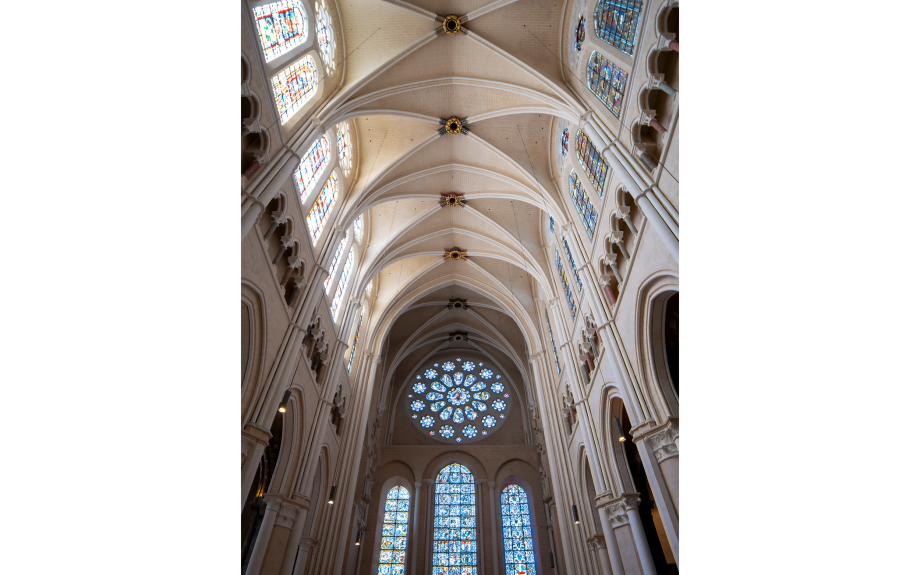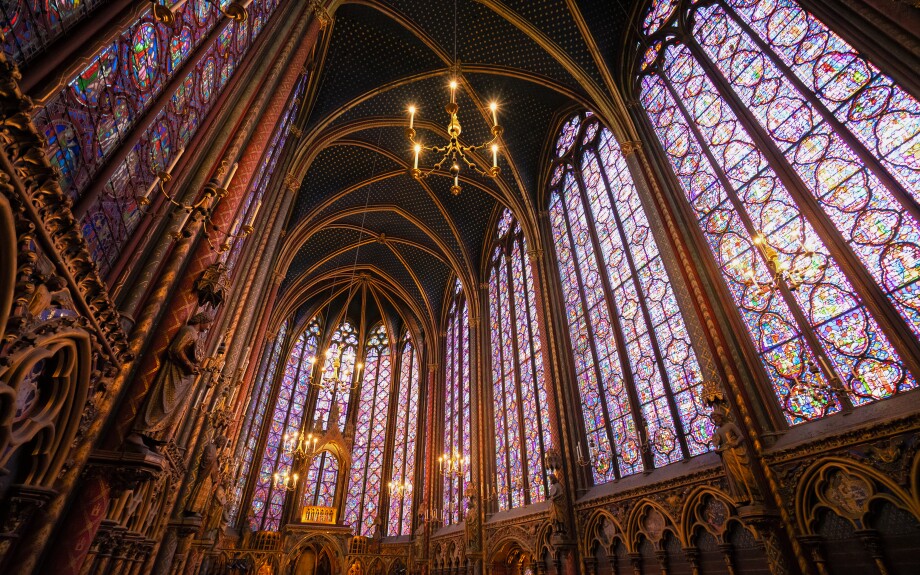About a year ago, a friend and I took a bucket-list trip to France. As art enthusiasts, we planned to visit all the museums and monuments we’d been dreaming of visiting since taking our first art history course in high school. On one of our first days in France, we took an hour train ride southwest of Paris to visit Chartres Cathedral, a church not as well-known as it’s Parisian counterpart Notre Dame, but every bit as spectacular. I remember standing in the middle of the nave (the center isle of the church), and tilting my head back as my eyes followed the lines of the pointed arches toward the tall stained-glass windows near the ceiling. I starred at the vaulted ceiling and windows until my neck ached, taking in the heavenly beauty of it all.
A few days later, I visited Sainte-Chapelle, a small chapel in the heart of Paris known for its stained glass. As I walked into the space, I was awed by 15 beautiful 45-foot stained-glass windows that bathed the room in periwinkle light. Every windowpane depicted a detailed Bible scene, beginning in Genesis, and continuing through the life of Christ. The outside light filtered through the stained glass and transformed the chapel into an otherworldly space.
As I stood and admired the beautiful Gothic design of both Chartres Cathedral and Sainte-Chapelle, I felt that I truly could have stayed there forever, admiring the craftsmanship of the unknown masons and artisans while basking in colored light. In those churches, though I don’t ascribe to their faith tradition, I felt much like I do in our temples—closer to God and closer to heaven. The beauty of those spaces filled my heart with longing, like heaven was a bit more tangible, and “my soul did yearn to be there” (Alma 36:22).
But visiting those monuments turned out to be much more than a checked bucket-list item—their beauty and spirit helped me gain a deeper appreciation for the temple and how it helps me grow closer to the Savior.
A Higher World
I recently took an art history course and learned about Abbot Suger, an influential figure in French artistic and religious history, who was charged by King Louis VI of France (1108–37) with the remodeling of Saint-Denis Cathedral. The medieval church had been the burial spot for all the French monarchs since the sixth century until that time. Suger wanted to transform the dark church into one filled with light, and his new design incorporated pointed arches and used architectural innovations to open the stone walls to large stained-glass windows. The distinct light and lines of Saint-Denis would spread across France, becoming hallmarks of the Gothic style and influencing the design of many structures.
In the remodeling process, Suger recorded the philosophies that guided his artistic decisions. In one of his writings, De Administratione, the abbot reflects on the spiritual power of the new artistic elements that had been incorporated into the structure.
“[When]—out of my delight in the beauty of the house of God—the loveliness of the many-colored gems has called me away from external cares … then it seems to me that I see myself dwelling … in some strange region of the universe which neither exists entirely in … the earth nor entirely in the purity of Heaven.” Suger continues that, through the beauty of the “many-colored gems” (windows), he could be transported from “this inferior to that higher world.”
Suger’s words resonate with me: that feeling I had while visiting Chartres Cathedral and Sainte-Chapelle had also called me away from external cares. And that was the feeling I often had in the temple—like I’d taken a step closer to heaven after walking through its doors.
Closer to Home
I have a vivid memory of sitting in a brown carpet-walled seminary classroom as my teacher taught about temple symbolism. He drew two circles on the whiteboard that overlapped, making a Venn diagram. He said that one circle represented the earth, the other represented heaven, and the sliver where they intersected represented the temple.
I latched onto the idea that the temple is a place where heaven and earth connect in a deep, meaningful way—and that through that connection, I could draw closer to my heavenly home. The concept immediately reminded me of an experience I had in the Provo City Center Temple not long before.
In 2016, after nearly four years of renovation and restoration, the Provo City Center Temple was complete. Late one Saturday, my parents, grandparents, and I decided at the last minute to visit the open house, and we happened to catch the last tour of the day. As we wound our way through the temple, I hung back from the crowd, trying to take in every detail that I could.
The last stop of the tour was the celestial room. The quiet, peaceful beauty of the space enveloped me and I remember thinking that I never wanted to leave that place.

Coincidentally, the design of the Provo City Center Temple is in the neo-Gothic or Gothic Revival style, which came about in the 19th century and is known for incorporating elements like long pointed arches and stained-glass windows into buildings. True to form, the celestial room’s high ceiling and stained-glass windows bathed the room in light, and the pointed arches of the windows and doors directed my gaze heavenward. I was only 16 when I stood in that celestial room for the first time, and I knew that it would be several years until I could stand there again. But the beauty of the space gave me the undeniable impression that this was the Lord’s own holy house, and I wanted to make it back one day.
When visiting Chartres Cathedral and Sainte-Chapelle as a 22-year-old art enthusiast, I felt much like I had as a 16-year-old standing in the celestial room of the Provo City Center Temple for the first time. True, the ceremonies and artistic styles of Chartres Cathedral and Sainte-Chapelle are very different than those carried out within Latter-day Saint temples, but those spaces are sacred and holy to the believers of their faith tradition, and the devotion of saints who built those spaces—and those who continue to worship there—only render the space more holy. I felt honored to stand in such beautiful, sacred spaces—they made me feel like I was in a heavenly place and filled me with a strong desire to make it back to my heavenly home.
The Covenant Path
Not only was I impressed with the stunning beauty of Chartres Cathedral and Sainte-Chapelle, but I was also inspired by the faith of the Christian stone masons, architects, carpenters, and other artists who built them. Their faith prompted them to create a beautiful space where they could feel closer to God.
Today, we likewise build temples to connect us to God and incorporate symbolism to show its spiritual importance. In fact, a Church Newsroom article describes why the beauty of temples is so important: “Because members see the temple as the house of God, the Church asks those who design and construct temples and their grounds to reflect that belief in what they create.” Similar to the Gothic cathedrals of old, the beauty of temples helps architects and Latter-day Saints visualize the temple as a place where God dwells and where we may symbolically enter His presence.
Visiting and learning about Gothic architecture has enriched my temple worship because I’ve learned that when I go to the temple, it’s not just the physical beauty of the space that helps me draw closer to Christ. When I stood in the Chartres Cathedral, it was the lines of the tall pointed arches that moved my soul heavenward. When I go to the temple, I'm inspired by its beauty and splendor, but ultimately it’s the covenants I make inside that point my soul toward the Savior in a way no other building can.
Everything about the temple points us to the Savior, from the lighting and design to the ordinances and the covenants we make inside those holy spaces. Covenants are important markers along the path that leads us back to and qualify us to enter our heavenly home. President Boyd K. Packer once taught, “Ordinances and covenants become our credentials for admission into [God’s] presence. To worthily receive them is the quest of a lifetime; to keep them thereafter is the challenge of mortality” (emphasis added).
We all know the common phrase: “Rome wasn’t built in a day.” Well, neither was Chartres Cathedral. According to the World History Encyclopedia, the first recorded presence of a cathedral in the city dates to 743 AD. But for the next three centuries, Chartres and its church would be sacked and attacked by Vikings and feudal lords. Undeterred, the people of Chartres began again to build a cathedral in 1024, and after extensive building, expansions, and renovation due to fire, Chartres Cathedral was completed 200 years later in 1220.
Much like the building of a cathedral can last over a lifetime, our journey along the covenant path requires hope, dedication, and faith all throughout our lives. Even though we may not have a 371-foot Gothic cathedral to stand as a testament of our faith, we can have our covenants.
Walking the covenant path is sometimes a challenge. For me, it requires commitment and recommitment to the Lord’s invitation to follow Him; it requires dedication and rededication to strengthening my faith as it ebbs and flows. I’ll be the first to admit I don’t walk the covenant path perfectly. But whenever I wander and doubt, I ultimately feel a yearning to be close to God and my covenants, and that always leads me back to the temple—the slice of my heavenly home.
▶You may also like: 39 Latter-day Saint temples influenced by local culture, beauty, and nature






